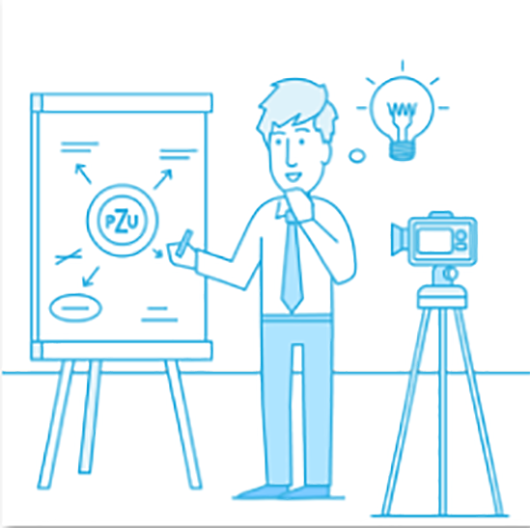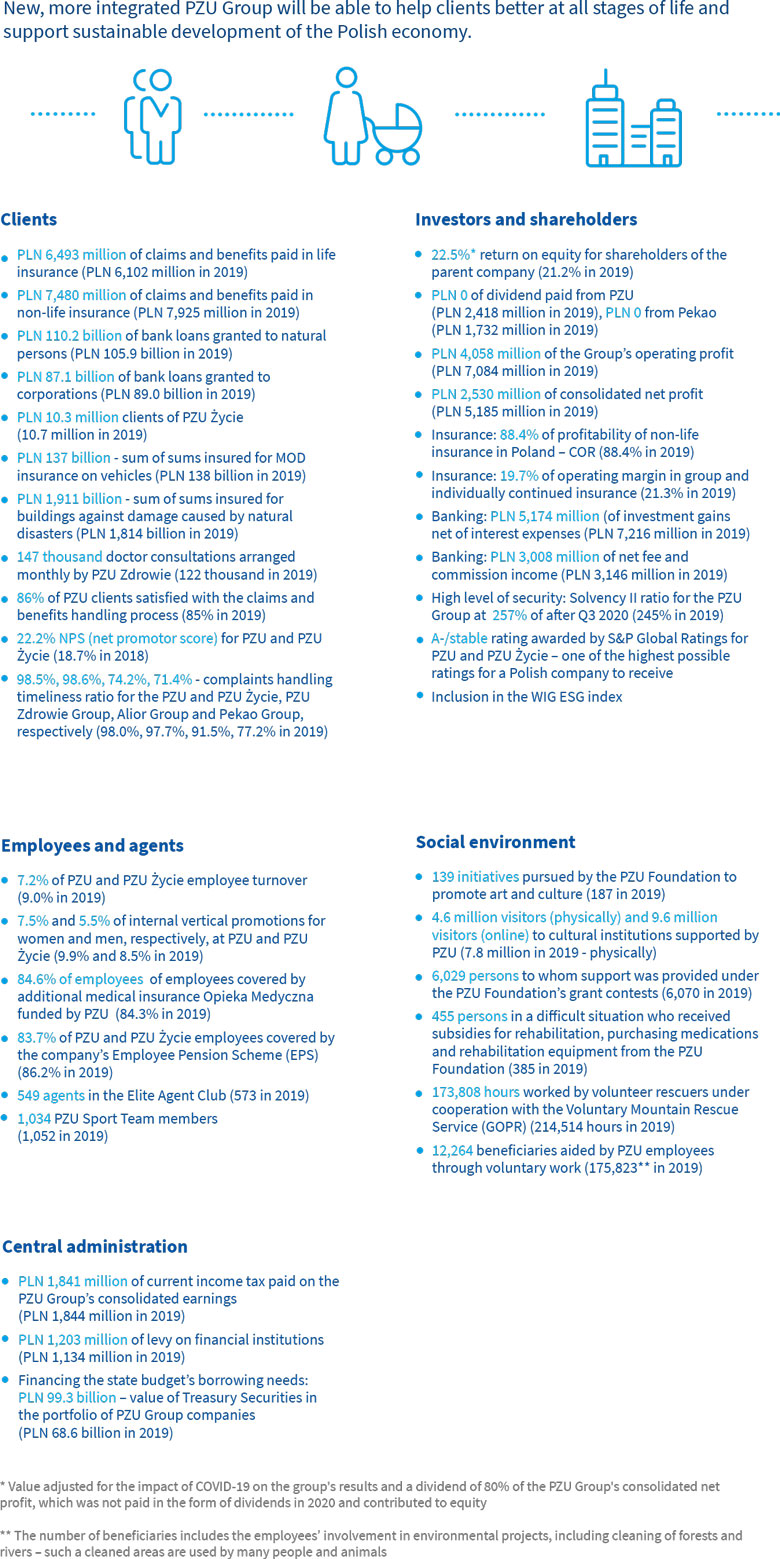Navigation Map
- strategy (insurance, health, investments, finances);
- sustainable development (sales, employees, social responsibility, natural environment and ethics).
PRACTICES
In the Chapter
GRIs
In the Chapter
GRIs
In the Chapter
List of GRIs
In the Chapter
GRIs
In the Chapter
GRIs
In the Chapter
GRIs
In the Chapter
GRIs
In the Chapter
GRIs
In the Chapter
GRIs
In the Chapter
GRIs
In the Chapter
Operating model
GRIs
- About the report
- Results
- Comment on the financial results for 2020
- Major factors contributing to the consolidated financial result
- PZU Group’s income
- PZU Group’s claims paid and technical provisions
- PZU Group’s acquisition and administrative expenses
- Drivers and atypical events affecting the results
- PZU Group’s asset and liability structure
- Contribution made by the market segments to the consolidated result
- Issuer’s financial results – PZU (PAS)
- Impact of the COVID-19 pandemic on the PZU Group’s results
- Business strategy (2017-2020)
- CSR strategy(2017-2020)
- Supplementary information and notes
- 1. Introduction
- 2. Composition of PZU Group
- 3. Shareholder structure
- 4. Composition of the Management Board, Supervisory Board and PZU Group Directors
- 5. Key accounting policies, key estimates and judgments
- 5.1 Impact of the COVID-19 pandemic on the estimates and assumptions
- 5.2 Changes in accounting policies and estimates, errors from previous years
- 5.3 Amendments to the applied IFRS
- 5.4 Explanation of differences between the 2019 annual consolidated financial statements and these consolidated financial statements
- 5.5 Consolidation principles
- 5.6 Measurement of transactions and balances denominated in foreign currencies and FX rates used
- 5.7 Purchase method
- 5.8 Classification of insurance contracts in accordance with IFRS 4
- 6. Segment reporting
- 7. Risk management
- 8. Equity management
- 9. Fair value
- 10. Gross written premium
- 11. Fee and commission income
- 12. Interest income calculated using the effective interest rate
- 13. Other net investment income
- 14. Result on derecognition of financial instruments and investments
- 15. Movement in allowances for expected credit losses and impairment losses on financial instruments
- 16. Net movement in fair value of assets and liabilities measured at fair value
- 17. Other operating income
- 18. Claims and movement in technical provisions
- 19. Fee and commission expense
- 20. Interest expenses
- 21. Acquisition costs
- 22. Administrative expenses
- 23. Employee expenses
- 24. Other operating expenses
- 25. Income tax
- 26. Earnings per share
- 27. Goodwill
- 28. Intangible assets
- 29. Other assets
- 30. Deferred acquisition cost
- 31. Property, plant and equipment
- 32. Investment property
- 33. Entities carried by the equity method
- 34. Loan receivables from clients
- 35. Financial derivatives
- 36. Investment financial assets
- 37. Receivables
- 38. Impairment of financial assets
- 39.Cash and cash equivalents
- 40. Equity attributable to equity holders of the parent
- 41. Technical provisions
- 42. Subordinated liabilities
- 43. Liabilities on the issue of own debt securities
- 44. Liabilities to banks
- 45. Liabilities to clients under deposits
- 46. Other liabilities
- 47. Provisions
- 48. Deferred income tax
- 49. Assets and liabilities held for sale
- 50. Lease
- 51. Assets securing receivables, liabilities and contingent liabilities
- 52. Contingent assets and liabilities
- 53. Offsetting financial assets and financial liabilities
- 54. Notes to the consolidated cash flow statement
- 55. Disputes
- 56. Transactions with related entities
- 57. Headcount
- 58. Other information
- Financial data (2019-2020)
- Financial data (2016-2020) Focus on: Results - check the highlights of the year!
- Comment on the financial results for 2020
- Market and business
- External environment
- Business model
- Structure of the Group
- Operating model
- Brand management
- Insurance
- Non-life insurance (PZU, LINK4 and TUW PZUW)
- Life insurance (PZU Życie)
- Insurance (international operations)
- Investments
- Investments (PZU TFI)
- Investments (PTE PZU)
- Health
- Health (health companies)
- Banking and strategic partnerships
- Banking (Bank Pekao, Alior Bank)
- Other operating areas
Focus on: Market and business - check the highlights of the year!
- Capitals (IIRC)
- Strategy and outlook 2021+
- Risk and ethics
- Objective of risk management
- Risk management system
- Risk appetite
- Risk management process
- PZU Group's risk profile
- ESG risks
- Risk vulnerability
- Reinsurance operations
- Capital management
- Ethical foundations of doing business
- Preventing corruption and conflicts of interest
- Whistleblowing System
- Transaction security
- Tax transparency
- Cooperation with suppliers Focus on: Risk and ethics - check the highlights of the year!
- Corporate governance
- Application of corporate governance rules
- System of control in the process of preparing financial statements
- Audit firm auditing the financial statements
- PZU's share capital and its shareholders
- Rules for amending the Company's Articles of Association
- Shareholder Meeting and shareholder rights
- Supervisory Board and Management Board
- Compensation paid to members of supervisory and management bodies
- Diversity policy Focus on: Corporate governance - check the highlights of the year!
- Shares and bonds
- Equity and bond market
- PZU's share price
- Banking sector on the Warsaw Stock Exchange
- PZU's investor relations
- Analysts' recommendations regarding PZU's shares
- PZU Group's Capital and Dividend Policy
- Debt financing of PZU, Bank Pekao and Alior Bank
- Rating
- Calendar of PZU's major corporate events in 2021 Focus on: Shares and bonds - check the highlights of the year!

What is the value creation model according to the international guidelines given by the International Integrated Reporting Council (IIRC)?
Integrated reporting makes it possible to combine material information pertaining to an organization’s strategy, approach to management, performance and future prospects in a way that reflects the financial, social and environmental context of an organization’s operations. The report depicts its approach to creating value over time while using the capital available to it. Capital is a resource which the organization can access and use to create value. Legally, however, it does not have to belong to the organization.
IIRC distinguishes the following six types of capital:
- Financial capital – resource containing funds that arises by providing funding through loans or grants, or is generated through operating activity. These funds include shareholder funds, equity and external capital;
- Intellectual capital – organization’s resource based on knowledge, experience, including among others intellectual property such as patents, copyrights, software, rights and licenses, the organization’s know how, motivation to improve and develop processes, leadership and cooperation and investments in new solutions and innovations facilitating development;
- Human capital – competences, know how, skills, experience and motivation of employees to develop and innovate, including the capacity of grasping and implementing the organization’s strategy;
- Social and relational capital – reputation, earned trust and the quality of relations with clients, communities and other stakeholders;
- Infrastructural capital – physical objects used by the organization in the process of producing goods or rendering services (branches, centers) as well as the distribution network formed by agents, private persons conducting agency activity and other partners cooperating with the PZU Group;
- Natural capital – renewable and unrenewable natural resources (including water, minerals and air as well as biodiversity and the protection of ecosystems) and processes whereby products or services are delivered.
“An organization should portray value creation from the perspective of inputs, outputs and outcomes.”
Source: <IR>framework, International Integrated Reporting Council
How does the PZU Group create value?

What does that entail in practice?

How outputs and impact are measured?

Investor Relations Team
e-mail: IR@pzu.pl
Magdalena Komaracka, IR Director, tel. +48 (22) 582 22 93
Piotr Wiśniewski, IR Manager, tel. +48 (22) 582 26 23
Aleksandra Jakima-Moskwa, tel. +48 (22) 582 26 17
Aleksandra Dachowska, tel. +48 (22) 582 43 92
Piotr Wąsiewicz, tel. +48 (22) 582 41 95
